A chase is not a complex proposition. It's linear, involves a bare minimum of two parties (chas-er, chas-ee) and ends once the former catches up to the latter. In technical terms, it doesn't sound like an overly engrossing affair (although, to be fair, I do suffer from excessive chase-ee bias)...
And yet!
If you look at any epoch of human culture, you will find endless examples of chases occupying (one might say) an unwarranted amount of the populace's attention...
In reality or fiction — foot chases, horse chases, dogs chasing intruders, people chasing each other; on skis, cycles (bi- and motor-), cars, boats, aircraft – even in freefall, to see who gets the benefit of The One Available Parachute – name me a mode of transport, it's bound to have a chase of its very own. Because, for humans, chases aren't technical – they are visceral, primordial things harkening back to a time when humans not fond of chases didn't get to eat (letting my forebears and compatriots to stay alive for One More Stressful Day).
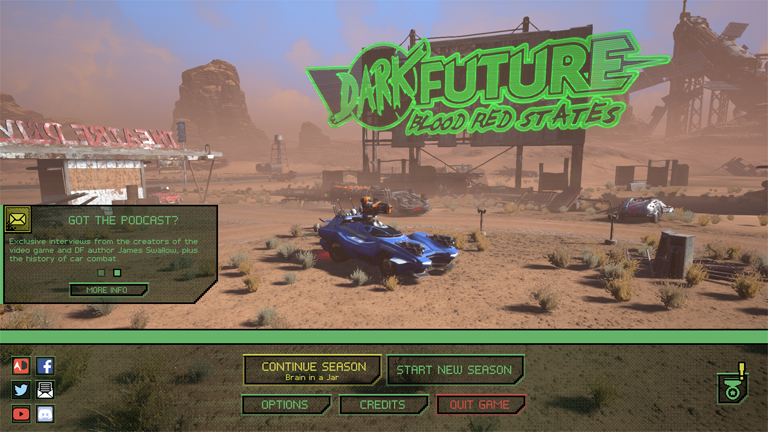
And it is this visceral, gut feeling that Dark Future: Blood Red States seeks (and mostly manages) to encapsulate in gameplay form.
Based on a little known, Games Workshop board game of the same name (which was released 9 years after Mad Max), Dark Future envisioned a bleak, dystopian, future United States of (gasp!) 1995, in which all police forces were privatized and the vast country divided into Policed Zones (large cities) and gangcult-ruled Non Policed Zones (everywhere in between). It was a turn-based game of vehicular combat, which received praise for its meticulous miniatures (a GW game with miniatures!? what were the chances...), but was lambasted for its outlandish cost and the limited resources it offered (a paltry 3 cars and 16 weapons for 48 1988 dollars).
For better or worse, the 2019 computer game adaptation by Auroch Digital follows the framework of the source material to a tee, offering limited gameplay at an exorbitant price.
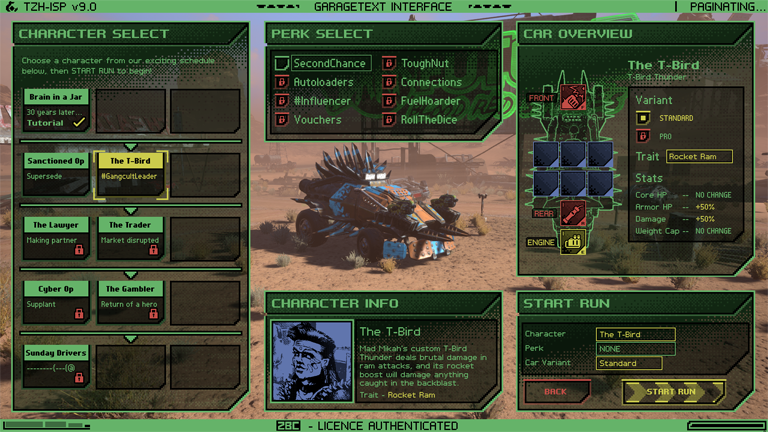
Dark Future: Blood Red States is a single player sorta-action, sorta-RTS game with roguelike mechanics that is divided into "Seasons." Each Season (of which there are eight) introduces a new vehicle, driver and completion goals. Completing a Season nets you perks which can make successive Seasons a bit more manageable. Its the same approach you've seen in every rougelike to date and nothing new.
Where the "driving" is concerned, the game lets you set the gear (forward, reverse) and speed of your vehicle, which can run in one of four lanes. It can be played in real-time, or slowed during "Command Mode", which lets you plan your moves in advance. All weapons (of which your car has three: front, rear and a 360 degree turret) and abilites have shortcut keys and – if you are quick enough – can be used without giving Command Mode a second thought.
In terms of gameplay, Dark Future is a mixed experience. The rigid, board game controls paired with real-time physics that ignore them, make for recurring frustration that is more bearable on Quota, Intercept or Blockade Run missions (where you are simply racking up kills), but will have you tearing out your hair during Data Hacks when your car is once again bowled out of position by a careening wreck that doesn't care One Whit about the game's rigid, four-lane road structure.
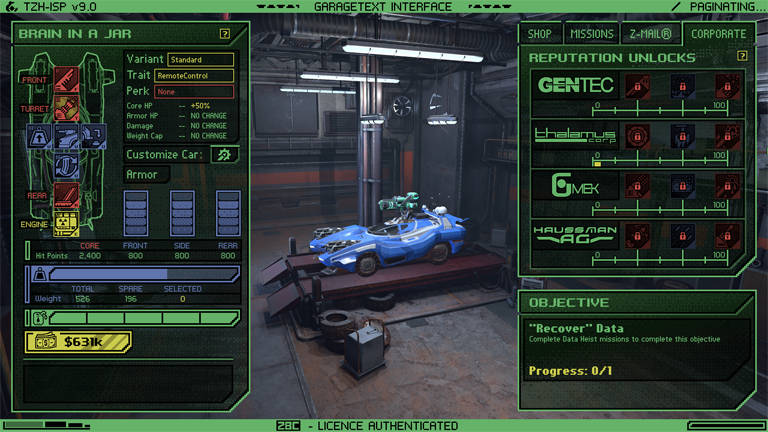
The seven mission types earn you money you can spend in between runs on upgrading your engine (which increases your car's core health and lets it carry more weight), purchasing new weapons or utilities (such as increased weapon type damage or stronger armor) or topping up your fuel (which is the lifeblood of every Season: each mission consumes fuel and the Season ends if you cannot afford any more). To limit the length of every Season, the cost of fuel increases every few missions.
Missions completed for sponsors increase your "Corporate Rank", which can unlock perks and powerful weapons in the shop and carries over between Seasons.
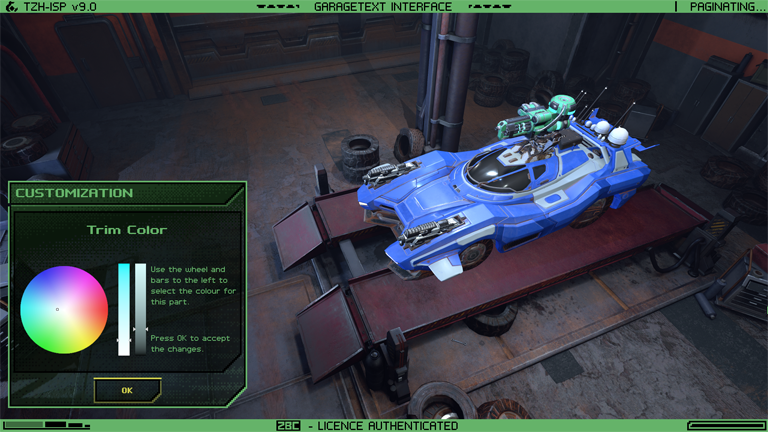
The cars have limited customization, allowing you to choose both colors of their paint scheme and license plate. It's a welcome addition, but a far cry from being able to build your own car (which, for a vehicular combat game, should have been a no-brainer).
And speaking of no-brainers: this game would have benefitted greatly from a basic character generator (maybe on par with the custom race creator in MOO2) for even more versatility. Being forced to play somebody else's character is never as satisfying as making your own, after all...
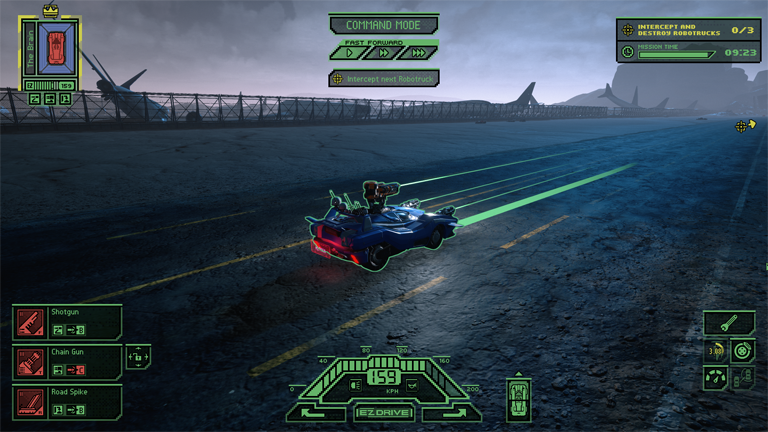
While the overall finish of the game is quite nice, with a retro treatment for the menus and genuinely pretty UE4 graphics, the game is hampered by limited replayability and uneven enjoyment. Since the devs went to all the trouble of making a real-time physics engine, it would have been nice for the control scheme to take full advantage of the fact. As it stands, the existing controls feel like a handicap aimed solely at the player.
Another downside to Dark Future is cost. While the game retailed for around 18 USD on release, both GoG and Steam currently have it listed for 24 – which it is definitely not worth. Between eight seasons and seven recurring mission types, there's maybe 10 bucks' worth of game here. Asking for more than twice that is simply unreasonable.
If you like vehicular combat, obscure Games Workshop titles, dystopian futures or just want a little sideline that will eat up 5-20 minutes of your time at a go, Dark Future: Blood Red States is a Viable Candidate of a game. Just make sure to snag it on sale (which on GoG can mean a 90% discount) and keep in mind that the gameplay experience is limited, the graphics engine does crash every now and again and the controls can be a little frustrating at times.
Pig Recommends:
-
-if you can somehow get your hands on 'em, Jack Yeovil's (Kim Newman's) four Dark Future books from the 90s (Krokodil Tears, Demon Download, Route 666 and Comeback Tour) are an odd, but enjoyable read; while they are definitely an acquired taste (do try one of his more mainstream works first – like, say, Drachenfels), they are competently written and weird enough to be unique;
-
-in need of a more generic, thrill-ride fix? try 2008's Death Race (movie); another "not great, not bad — 100% watchable" Paul W.S. Anderson vehicle;
